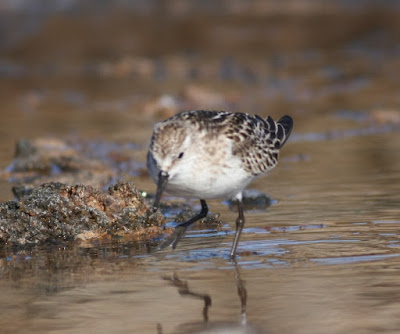The previous "Willow Warbler" post has given me the cue to write the following notes on species status, for the benefit of visiting birders to the island, especially those coming from European countries. If you note a touch of irritation, the reason will become clear towards the end...
As explained in the said post, the "humble" Willow Warbler (
Phylloscopus trochilus) is a migrant to La Palma, not a resident species...so if you see one on the island, it's worth sending your sighting to the regional recorder, and/or congratulating yourself for having found something exceptional. All such records are later published in Ardeola, the bi-annual Spanish Birdlife journal, and they add to knowledge of species distribution.
In other words, it's important to be aware of the status of the various species you observe on the island, in order to put your sightings into context, and decide when it's worth reporting them. You will then be able to contribute useful data to SEO/Birdlife... if you wish to do so.
Reliable details on species status have been available for many years in a number of publications, including these two popular field guides in English:
"Birds of the Atlantic Islands" Tony Clarke, Helm Field Guide
"Field Guide to the Birds of Macaronesia" Eduardo García-del-Rey, Lynx Edicions
The latter book is the more recent of the two, and is regularly cited in my blog posts, but both guides are recommendable.
To say that La Palma is "under-watched" is a gross understatement. It can be safely assumed that many vagrant birds turn up every year, only to go completely unnoticed by the island's inhabitants, let alone reported. There are also a number of resident species which are becoming increasingly scarce; some are presumed already extinct, others are on the brink of extinction. In the absence of active birdwatchers who report their sightings, it is simply impossible to assess the exact situation of the following:
Rock Sparrow (
Petronia petronia), Corn Bunting (
Emberiza calandra), Goldfinch (
Carduelis carduelis), European Greenfinch (
Carduelis chloris), European Serin (
Serinus serinus).
If you observe any of the above species on the island of La Palma, please report your sighting to the Regional Recorder jalorenzo@seo.org, or send me an email and I'll pass on the information. Also, any updates on the Hoopoe (
Upupa epops), or the Barn Owl (
Tyto alba) would be greatly appreciated. Photos are always useful as evidence, but not essential.
So why the irritation? Well, take a look at the Avibase checklist for La Palma, an increasingly popular online resource for travelling birders, described on its homepage as "the world bird data base":
http://avibase.bsc-eoc.org/avibase.jsp (You'll need to enter Spain, then the Canary Islands, then La Palma).
On the Avibase checklist, there is no clear definition of status; some of the birds on the list are not residents on La Palma at all, but a European birder could well be forgiven for assuming they are; the various species labelled Rare/Accidental include infrequent, but almost annual migrants lumped together with unique, "one-off" sightings for the whole of Spain; no distinction is drawn between abundant resident species, and extremely scarce or possibly extinct ones; and some species are listed which are found on some of the other Canary Islands, but not on La Palma, etc. etc.
Similarly, is it clear from the list that there are absolutely NO resident ducks or waders on the island, or are birders supposed to draw that conclusion themselves? Furthermore, the only Chiffchaff found here is the
canariensis species, the only Blue Tit is the
palmensis subspecies, and the only Chaffinch on the island is the
palmae subspecies.
Admittedly, the creator of the checklist does apologize for any inaccuracies in the same, and makes a plea for help in correcting any errors. But come on, that's too easy! First, you uncritically lift data from the net, paste it into a list format, and then ask for volunteers to correct it for you. Wouldn't it have been better to check with an authoratitive source beforehand (ie. copy the information contained in a field guide), or at least send the list for revision to the Regional Recorder?
Quite frankly, the whole thing comes across as rather sloppy, and needs re-working from start to finish, IMHO. After consulting the said list, people have asked me where they can see Osprey (
Pandion haliaetus) on La Palma: the answer is, you can't...unless you happen to coincide with a migratory Osprey that passes through once every couple of years or so. You can similarly forget about the Lesser Kestrel (
Falco naumanni) for similar reasons (although I am not aware of an accepted record for this species on La Palma in the last 10 years). On the other hand, what about the various species - waders especially - that
have been recorded on the island, but which are
not included on the Avibase checklist?
So, the message to visiting birders is simply this: don't rely on the Avibase checklist, and consider getting yourselves a copy of one of the field guides mentioned above. Amongst other things, you'll save yourselves time and effort in the field trying to separate the nominate Goldcrest (
Regulus regulus) from the Canary Islands Kinglet (
Regulus teneriffae), which are both present on the Avibase checklist for La Palma, but unfortunately are not present on the island itself. On La Palma you only get the Goldcrest subspecies (
Regulus regulus sub.
ellenthalerae).
Having got all that off my chest, let me end by wishing visitors "happy birding" on the island...and keep your eyes open for migrants: the season has just started!


















